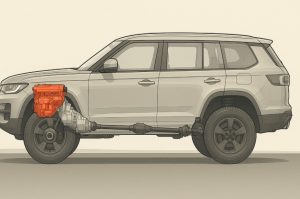What’s the Main Benefit of Driving a Four-Wheel-Drive Vehicle?
Why is there a growing preference for four-wheel-drive (4WD) vehicles among British motorists for Fleets? The UK’s diverse geography, frequent weather changes, and a steady interest in rural or off-road travel have led many drivers to reassess their vehicle choices.
From snow in the Scottish Highlands to muddy tracks in the Midlands, UK roads present a range of challenging conditions. As a result, many are turning to four-wheel-drive systems for improved safety, capability, and control.
Yet among all the touted benefits, one stands out: the enhanced traction a 4WD vehicle provides. But what does that mean in real-world driving, and how does it influence everything from performance to safety and comfort?
What Is Four-Wheel Drive and How Does It Function?

Four-wheel drive is a drivetrain system in which power from the engine is delivered to all four wheels simultaneously. This is achieved by locking the front and rear driveshafts together, so both axles rotate at the same speed. The result is significantly improved grip and control across a wide range of road and terrain conditions.
There are several variations of 4WD systems in use today. Understanding the differences helps drivers choose the most appropriate option for their needs:
| Type of 4WD | Description |
| Full-Time 4WD | Power is sent to all four wheels at all times, ideal for varying conditions |
| Part-Time/Manual 4WD | Driver-controlled engagement of the system, often used in pickups and SUVs |
| Automatic 4WD | Adjusts power distribution as needed, blending performance and efficiency |
Each system offers varying levels of performance and fuel economy, but the core principle remains the same, better distribution of power results in more stability and control, especially when traction is compromised.
How Does 4WD Enhance Traction and Road Holding?
The primary and most significant benefit of four-wheel-drive vehicles is improved traction. When driving on wet, icy, or uneven surfaces, traction loss can quickly lead to dangerous situations. With a 4WD system, power is distributed evenly to both front and rear wheels, increasing the vehicle’s ability to “hold the road” regardless of surface conditions.
Road holding refers to a vehicle’s ability to stay grounded and maintain directional control while accelerating, braking, or cornering. A 4WD system dramatically improves this, particularly on inclines or loose terrain such as gravel, mud, and snow. In comparison, two-wheel-drive vehicles are more prone to slippage as only two wheels are tasked with transmitting power and maintaining grip.
Moreover, 4WD systems often work in tandem with advanced traction control technologies, further enhancing a vehicle’s responsiveness in difficult conditions. This makes a considerable difference in high-risk scenarios such as overtaking in the rain or descending a slippery hill.
Is Four-Wheel Drive Really Necessary for Off-Road Conditions?

For those venturing off the beaten path, whether for work or leisure and four-wheel drive is not just a convenience but a necessity. Vehicles equipped with 4WD systems are specifically designed to handle uneven terrain, steep gradients, and surfaces with reduced friction such as sand, mud, or snow.
Many 4WD vehicles also come with higher ground clearance, reinforced suspension systems, and specially engineered tyres, all of which contribute to their off-road prowess. The ability to distribute power to all four wheels means the vehicle can continue moving even if only one or two wheels maintain contact with the ground. This is particularly useful when traversing ruts, rock-strewn trails, or waterlogged fields.
In the UK, off-road driving is not limited to adventurous outings. Many rural communities, farms, and construction sites require frequent travel across fields or unpaved roads. For these applications, a 4WD vehicle often becomes an essential part of everyday life.
What Role Does 4WD Play in Towing and Load-Carrying Capabilities?
Towing a heavy trailer or caravan places a significant demand on a vehicle’s drivetrain, stability, and braking systems. Four-wheel-drive vehicles are generally better equipped for such tasks thanks to their robust construction and enhanced torque delivery.
Distributing power across four wheels reduces strain on the engine and prevents tyre slippage when moving uphill or launching from a standstill with a heavy load. Additionally, the extra weight of 4WD vehicles contributes to improved stability when towing, minimising sway and increasing driver confidence.
Whether towing a boat to the coast, transporting machinery, or simply pulling a caravan through countryside roads, a 4WD system makes the job safer and more manageable.
How Does 4WD Improve Overall Vehicle Stability?

Vehicle stability is essential for safe driving, especially in adverse weather or when carrying passengers and cargo. A 4WD system enhances stability by ensuring that torque is shared between both axles. This power balance helps maintain better control during acceleration, especially on split-traction surfaces where one side of the vehicle may have more grip than the other.
The increased stability also improves handling when cornering, climbing, or braking. By reducing the load on any single wheel, 4WD systems allow tyres to perform more efficiently, translating into smoother manoeuvres and better overall vehicle response.
It is worth noting that while 4WD systems increase stability during motion, they can also increase braking distance slightly due to the additional weight. However, this is usually offset by the improved traction and grip provided in the first place.
Are There Downsides to Using a Four-Wheel-Drive System?
Despite its clear advantages, a 4WD system is not without compromises. The most immediate concern is cost. Vehicles with four-wheel-drive systems are generally more expensive to purchase than their two-wheel-drive counterparts, primarily due to the added complexity and components involved.
Another consideration is fuel efficiency. Because 4WD vehicles are heavier and require more energy to power all four wheels, they tend to consume more fuel, especially when the system is engaged continuously. Many modern vehicles now include selectable 4WD modes, allowing the driver to switch between two and four-wheel drive to conserve fuel when full traction is unnecessary.
Maintenance is another factor. The addition of transfer cases, drive shafts, and differentials makes the drivetrain more complex and expensive to service. Neglecting regular maintenance can lead to costly repairs down the line.
Lastly, increased stopping distances due to vehicle weight must be accounted for. Drivers need to maintain longer following distances and adjust their braking habits, especially when driving at speed or in wet conditions.
What Situations in the UK Demand the Use of 4WD?

The UK’s driving conditions vary widely, and many regions see seasonal challenges that put regular drivetrains to the test. Four-wheel drive is particularly useful in:
- Rural areas where roads may be poorly maintained or unpaved
- Snow-prone regions such as Scotland, Cumbria, and Wales
- Coastal zones with sand or steep hills
- Areas affected by flooding or waterlogged roads
For commercial drivers, farmers, outdoor professionals, or even families who enjoy country escapes, the ability to confidently drive in all conditions is invaluable.
How Does 4WD Compare with AWD and 2WD Systems?
To fully appreciate the benefits of four-wheel drive, it’s helpful to see how it stacks up against other drivetrain systems:
| Feature | 4WD | AWD | 2WD |
| Power Distribution | Driver-controlled or full-time | Automatically adjusted | Front or rear only |
| Off-Road Capability | High | Moderate | Low |
| Fuel Efficiency | Lower | Moderate | High |
| Traction in Slippery Conditions | Excellent | Good | Limited |
| Best Use Cases | Off-road, towing, rural driving | Mixed terrain, all-weather driving | City or dry road use |
While AWD systems are more suited to light off-roading and occasional poor weather, 4WD excels in heavy-duty and off-road applications. For drivers who primarily stick to urban environments, a 2WD vehicle may still be the more economical choice.
Does 4WD Improve Safety and Comfort?
A 4WD system enhances safety by allowing better control when grip is compromised. Whether it’s avoiding wheel spin on icy roads or maintaining direction on muddy tracks, the system offers a tangible advantage.
Comfort is also improved through better suspension systems, higher ride height, and increased passenger space, common features in most 4WD vehicles. These elements make journeys less fatiguing, especially over long distances or uneven surfaces.
However, it’s essential to note that 4WD does not make a vehicle invincible. Overconfidence, excessive speed, and poor judgement can still lead to accidents. Safe driving practices should always accompany the use of advanced systems like four-wheel drive.
FAQs About Four-Wheel-Drive Vehicles
Is four-wheel drive suitable for daily city driving?
While it can be used in the city, it’s not always necessary and may result in higher fuel usage. For urban settings, 2WD or AWD may be more practical.
Can I switch off the 4WD system to save fuel?
Yes. Many modern 4WD systems are selectable, allowing drivers to switch between two and four-wheel drive to conserve fuel.
Are 4WD vehicles better in snow?
Absolutely. They offer superior traction on snowy and icy roads, especially when paired with winter tyres.
Is maintenance more expensive for 4WD cars?
Yes. Due to their complex systems, maintenance and repair costs are generally higher than for 2WD vehicles.
Does 4WD improve acceleration?
It improves acceleration on slippery or uneven surfaces but doesn’t necessarily enhance performance on dry, flat roads.
What happens if I use 4WD on dry tarmac?
Using 4WD on dry pavement can increase tyre wear and strain the drivetrain. It’s best reserved for conditions that need extra traction.
Do 4WD vehicles have a higher resale value?
Generally, yes. Their durability and versatility often make them more attractive in the used car market, especially in rural regions.
READ NEXT:
- Older Drivers Car Tax Changes Explained: How New Rules Could Affect You?
- How Much Does a Deliveroo Driver Make?
- Reeves Considers Changes to Non-Dom Inheritance Tax Amid UK
- DWP Fuel Allowance – What Pensioners in the UK Need to Know for 2025/26?
- Top 12 Jobs That Pay £200K Plus a Year in the UK | High-Paying Careers







